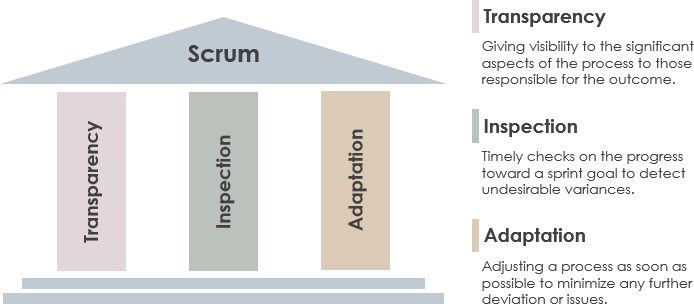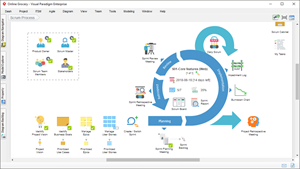SCRUM uses an empirical approach (or sometimes called empiricism) in order to adapt to the changing requirements of the customer. Empiricism is the act of making decisions based on what is actually experienced. Empirical approach means working in a fact-based, experience-based, and evidence-based manner, and in particular, progress is based on observations of reality, not fictitious plans based on large amount of upfront requirements.
In short, we can learn and improve upon past mistakes and experiences. The three pillars of Scrum that uphold every implementation of empirical process control are: Transparency, Inspection, and Adaptation as shown in the Figure below:

Transparency in Scrum can be realized by scrum tools such as, Product Backlog, Task Boards and Burndown charts, Daily Stand-ups, Retrospectives, Definition of done, Sprint Reviews and etc. These are used to transfer the flow of work through cross functional team. This is one of the key advantage in SCRUM – allowing visibility with regards to the progress of work and team. This means when the team is achieving its goal, those responsible for it can be recognized and appreciated for the efforts.

Best Scrum Software Every Project Needs
A powerful scrum software that supports scrum project management. It features scrum tools like user story map, product backlog management, sprint backlog management, task management, daily scrum meeting, sprint planning tool, sprint review tool, sprint retrospective tool, burndown, impediment, stakeholder and team management.
Scrum artifacts must be frequently inspected and progress towards a goal to detect undesirable variances. Inspection in Scrum can be realized by scrum activities such as:
In Agile world, we always embrace and Adapt changes, so that we can constantly improve. Adaptation means that we change what does not work or what could work better. It means that we constantly run small experiments, keep what is working and change when we fail. We use the results from our inspections to decide which experiment to run next, for example:
In Scrum, decisions are made based on observation and experimentation rather than on detailed upfront planning. Empirical process control relies on the three main ideas of transparency, inspection, and adaptation. This means that of the outcomes of a project should:
In conclusion empiricism and the three pillars are not just important to the Scrum process they’re the foundation of it. It is how your team achieves continuous improvement both in the products you create and in the processes you use for your team. The roles, events and artifacts only work because of their adherence to value based incremental improvements produced by embracing frequent feedback and embracing change.
| About Visual Paradigm |
 Visual Paradigm help organizations stay competitive and responsive to change faster and better in today’s fast changing environment. Our award-winning products are trusted by over 320,000 users in companies ranging from small business, consultants, to blue chip organizations, universities and government units across the globe. It enables organizations to improve business and IT agility and foster innovation through popular open standards and process frameworks.Visual Paradigm, a killer Agile feature in 2018, introduced Scrum Process Canvas for automating the way a Scrum team to create, manage and deploy software application that empowers the team to continuously improve their performance at unprecedented speed and scale. Manage the Entire Scrum Process in One Page Automate the Scrum Framework in a fun and enjoyable dashboard with eye-catching updated status. Manage Backlog, Multiple Sprints of different Scrum Roles with a single-page visually executable canvas Allow instantly access, review and generate scrum artifacts and related documents to be archived in the Shared Cabinet Automate the Scrum events and related activities with self-explanatory instructions, samples and required document templates. Visual Paradigm help organizations stay competitive and responsive to change faster and better in today’s fast changing environment. Our award-winning products are trusted by over 320,000 users in companies ranging from small business, consultants, to blue chip organizations, universities and government units across the globe. It enables organizations to improve business and IT agility and foster innovation through popular open standards and process frameworks.Visual Paradigm, a killer Agile feature in 2018, introduced Scrum Process Canvas for automating the way a Scrum team to create, manage and deploy software application that empowers the team to continuously improve their performance at unprecedented speed and scale. Manage the Entire Scrum Process in One Page Automate the Scrum Framework in a fun and enjoyable dashboard with eye-catching updated status. Manage Backlog, Multiple Sprints of different Scrum Roles with a single-page visually executable canvas Allow instantly access, review and generate scrum artifacts and related documents to be archived in the Shared Cabinet Automate the Scrum events and related activities with self-explanatory instructions, samples and required document templates. |